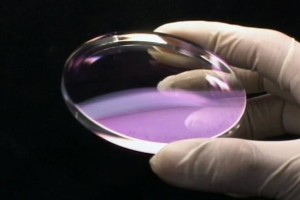RUB RESISTANCE – When printed materials rub against machinery during finishing operations or against each other during shipping or handling, the printed surface is subject to a rubbing action that tends to wear or scratch the printed surface. Water-based coatings applied over the printed surface help to improve the rub resistance. Due to the many variations in characteristics of printing substrates, inks used, and manner of application, it is impractical to establish a single standard number of rubs. Standards should be set for each individual application.
Useful advice : many jobs have poor rub resistance because too much anti-offset powder (spray powder) is used. While this material aids in block resistance of the job, it can cause excessive scratching! Always run powder to a minimum.
SLIPPERINESS– The coefficient of friction [COF] is a measure of the frictional force resisting movement of the coated surface to the force applied. The Slide Angle Tester [see picture below] is used to measure COF. Coatings generally can be made to be as slippery or as skidresistant as the printer desires. There are trade-offs, as you might imagine. Ultra-slippery coatings cannot be used as a UV primer. They also have less latitude for foil stamping and gluing. Some non-skid coatings have only average rub and block resistance.
VISCOSITY – Coating viscosity is thickness or resistance to flow. Viscosity greatly affects coating transfer rate, except in anilox [gravure] systems. The higher the viscosity, the higher the transfer rate. Coatings too high in viscosity will transfer too much coating on the paper. Coatings too thin will not transfer enough coating to the paper. Fast-drying coatings will have a tendency to lose water during the course of a production run. Keeping the lid on the drum can minimize this effect. The pressmen should check coating viscosity every few hours. It is recommended for coatings to be stored and used between 18 and 26 Celsius, to minimize any viscosity changes on-press.

